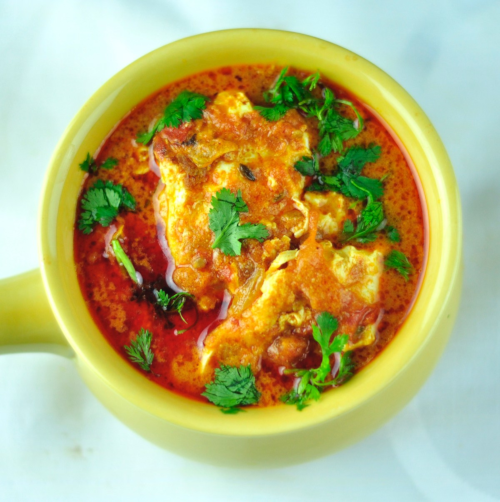Mama’s Punjabi Recipes – Torde Ande di Turri (Cracked Egg Curry)
 Here is another simple Punjabi recipe that that comes in handy when suddenly lots of people pop in or you are in a bind for time. It is quite tasty and goes well with hot roti. So, by popular demand for those looking for an easy recipe, below is a reprint of Mama’s Torde Ande di Turri recipe, with some additional comments and directions.
Here is another simple Punjabi recipe that that comes in handy when suddenly lots of people pop in or you are in a bind for time. It is quite tasty and goes well with hot roti. So, by popular demand for those looking for an easy recipe, below is a reprint of Mama’s Torde Ande di Turri recipe, with some additional comments and directions.
Ande (eggs) are very popular all over India, but especially so in the north during winter time. It is common to find cart vendors selling quick, hot boiled eggs, peeled and sliced if you want, with spices, to warm people up. During warm months, these vendors sell eggs any style for those who have to eat quickly.
Eggs are also very popular at home, especially for the nashta (breakfast) which usually comes an hour or two after morning chai (tea), and the most popular way is an omelet with onions eaten with a crispy, hot parantha!
Eggs are, of course, popular all around the world. In India, which is a predominantly vegetarian country, some vegetarians do eat eggs (mostly on doctor’s orders) to supplement their protein intake.
Egg production has grown tremendously through large scale hen raising methods in huge chicken farms. So more and larger eggs are now sold on the streets in cardboard crates, even though they are not usually refrigerated and you can’t always trust the vendor who says “Bus, doh din purane hain” (Oh, they’re only two days old). But the real reason, I think, is that eggs (as with most vegetables too) sold in India just taste better!
Here is a quick, easy recipe to make for those unannounced guests or for when you don’t have anything else in the fridge and everyone is inpatient and hungry. It goes well with rice or roti.hee makes browning the atta more difficult.
Ingredients:
- 4 large ande (eggs)
- 1 large pyaaz (onion)
- 1 medium tamater (tomato) – soft ones are best
- Spices: namak (salt), mirch (red pepper), haldi (turmeric) and sukha dhania powder (dried coriander seed powder)
- 1 medium clump of adrak (ginger root)
- 1 medium kernel of lasan (garlic)
- 3 cups of water
- 2 tablespoons of vegetable or olive oil
- Tomato paste to taste
Directions:
1.Chop the ginger, onions and garlic and brown them in the oil in a saucepan .
2. Chop the tomato in chunks and add to the mixture and stir till the masala is soft and thick. Add the spices to your taste – if you have others you wish to use, add them too. Add half a tablespoon of tomato paste, to enhance the taste, texture and color.
3. Now add the water and let the gravy thicken up a bit and bring to a rapid boil.
4. Crack the eggs open over the gravy and drop them in and throw away the shells. Be careful no pieces of the shell fall in! It is best to drop the eggs in open gravy and not on top of each other. Wait till each egg sets a little before dropping the next one in.
5. Let the curry boil for 10 minutes and set for another 5 to 10 minutes to allow the flavor to seep through the egg yolk.
6. Serve with hot roti or rice.
MAMA’S TIP OF THE WEEK: FOR WELL-COOKED AND TASTY DISHES, LEARN TO CONTROL THE HEAT
How often have I looked on as someone cooks a dish or makes roti or paranthas quickly over high heat and had to admonish them to “turn the heat down”?! They’ll argue with me that they’re trying to cook fast and “not to worry, it’ll be fine”. Often the result is that the dish doesn’t have enough time to simmer and soak in the flavor or the roti or parantha has dark brown overheated spots on them.
For a better tasting dish – and better looking roti or parantha – always turn the heat down to medium or even medium low once the initial time to heat the utensil is over. Then there is enough residual heat to cook the rest of the way through at an even temperature and the roti and paranthas won’t have the dark spots. You’ll also have less stress of continuously stirring or turning the food!

Shakuntla Malhotra is a skilled cook of Punjabi dishes made in the old-fashioned style that she learnt as a young woman in her ancestral home in Lyallpur, India (since renamed Faisalabad) before it became part of Pakistan after the Partition in 1947. People have often admired her cooking for its simplicity and taste that comes with each mouthful. Even in her late-eighties, she continues to cook daily and agreed to share her delectable Punjabi recipes for future generations.
